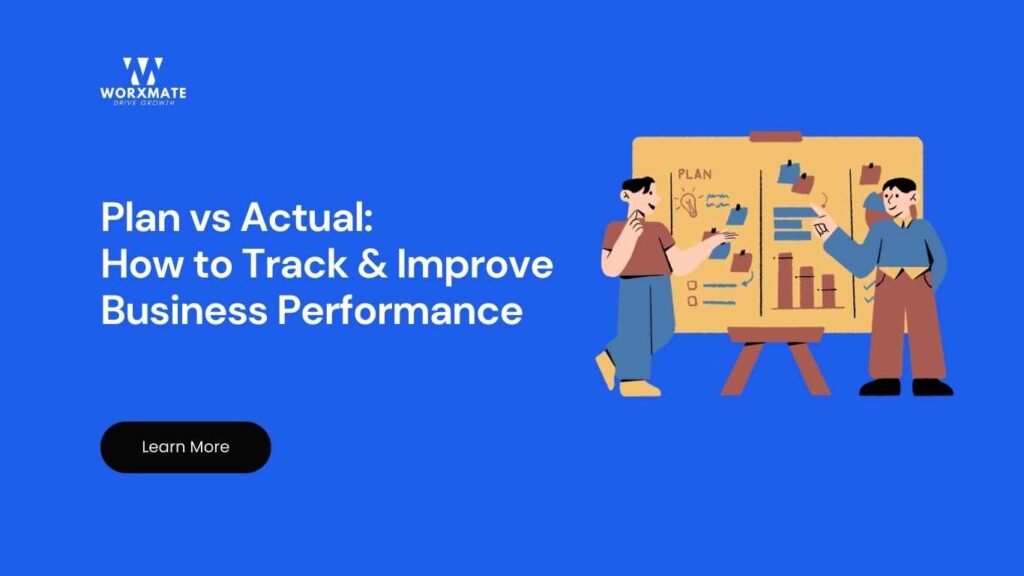Summary:
Plan vs actual is the process of comparing your business goals or forecasts with the real outcomes achieved. This comparison helps identify gaps, understand performance, and make informed decisions to improve future planning. By regularly reviewing planned versus actual results, organizations can increase accountability, optimize resources, and adapt quickly to changing conditions-ultimately driving better business success.
What Does Plan vs Actual Mean and Why Is It Important?
Every business sets goals and creates plans to achieve them. However, the real challenge lies in measuring how well these plans translate into actual results.
The term plan vs actual refers to the process of comparing your forecasted targets with what truly happened. This comparison helps organizations understand their performance, identify gaps, and make informed decisions.
Without regularly reviewing planned versus actual outcomes, companies risk continuing ineffective strategies or missing opportunities to improve. Whether you’re managing projects, sales, or budgets, this analysis provides clarity and accountability, ensuring your team stays aligned and focused.
What Is Plan vs Actual Analysis?
At its core, plan vs actual analysis involves:
- Setting clear, measurable targets (the plan)
- Tracking real-world performance data (the actual)
- Comparing the two to identify variances
This process is often used in financial management but applies broadly across business functions such as project delivery, marketing campaigns, and operational efficiency.
Why Should You Pay Attention to Planned vs Actual Results?
- Improves Forecast Accuracy: Learning from past discrepancies helps you create more realistic future plans.
- Enhances Resource Allocation: Knowing where you over- or under-perform allows better distribution of time, money, and effort.
- Promotes Accountability: Teams become more responsible when outcomes are tracked against commitments.
- Supports Agile Decision-Making: Quick identification of variances enables timely course corrections.
How to Conduct an Effective Plan vs Actual Review
Performing this analysis doesn’t have to be complicated. Follow these steps for a clear and actionable review:
- Define Your Objectives Clearly: Ensure goals are specific and measurable.
- Develop a Detailed Plan: Use historical data and market insights to forecast realistic targets.
- Collect Accurate Data: Use reliable tools and systems to capture actual results.
- Compare and Calculate Variances: Identify where results differ from the plan.
- Analyze the Causes: Understand why variances occurred-whether due to external factors, execution gaps, or assumptions.
- Implement Improvements: Adjust your strategy or operations based on findings.
| Month | Planned Sales | Actual Sales | Variance |
|---|---|---|---|
| January | $50,000 | $45,000 | – $5,000 |
| February | $60,000 | $65,000 | + $5,000 |
| March | $70,000 | $68,000 | – $2,000 |
This simple table highlights where sales exceeded or fell short of expectations, guiding managers on where to focus efforts.
Case Study: How Statista Improved Planning Accuracy
Statista, a global data and business intelligence provider, faced challenges with fragmented planning processes that relied heavily on spreadsheets. This led to inconsistent data and slow reporting, making it difficult to compare planned vs actual outcomes efficiently.
By implementing a centralized financial planning platform, Statista was able to:
- Consolidate data into a single system
- Automate report generation, reducing time from hours to minutes
- Foster collaboration across departments
- Increase accuracy and accountability in budgeting
According to Petra Winkelmann, Team Lead at Statista:
“Generating reports now takes minutes instead of hours; that’s a significant time saving.”
This transformation allowed Statista to respond faster to market changes and improve overall financial management.
Common Challenges in Comparing Planned vs Actual Results
Many organizations struggle with:
- Data Silos: Disconnected systems make it hard to get a complete picture.
- Manual Processes: Spreadsheets and manual entry increase errors and delays.
- Lack of Clear Ownership: Without accountability, follow-up actions are neglected.
- Slow Feedback Loops: Delayed analysis means missed opportunities for timely adjustments.
Overcoming These Issues
- Invest in integrated planning and performance management tools.
- Standardize data collection and reporting processes.
- Assign clear roles for monitoring and acting on variances.
- Use real-time dashboards to keep teams informed.
How Worxmate’s OKR Software Helps You Close the Gap
Worxmate offers a powerful solution to simplify the plan vs actual process by enabling organizations to:
- Set transparent objectives and key results (OKR)
- Track progress in real time with intuitive dashboards
- Automatically sync actual performance data with planned goals
- Generate insightful reports highlighting variances and trends
- Foster collaboration and accountability across teams
By using Worxmate, businesses can reduce manual work, improve accuracy, and make faster, better-informed decisions.
Ready to take control of your business outcomes?
Book a OKR Demo with Worxmate today and experience how seamless plan vs actual tracking can transform your organization.
Conclusion
Bridging the gap between your planned objectives and actual results is essential for sustained business success. Performing regular plan vs actual reviews empowers your team to identify opportunities, correct course, and optimize resources.
With solutions like Worxmate’s OKR Tracking software, this process becomes more efficient, collaborative, and insightful.



